In 1983, NASA received delivery of Discovery, the third space qualified vehicle in the agency’s space shuttle fleet. During the launch attempt for the STS-41D mission on June 26, 1984, Discovery’s onboard computers halted the countdown four seconds before liftoff, and after two of its main engines had already ignited. The six astronauts safely egressed the orbiter. This first on-the-pad abort of the shuttle program required the vehicle’s return to its assembly building for replacement of the faulty engine that caused the shutdown. The resulting two-month delay caused a shuffling of the mission’s payloads, but Discovery finally lifted off on Aug. 30, and the astronauts completed a successful six-day mission, deploying three commercial satellites, testing a new solar array, and conducting a commercial biotechnology experiment.
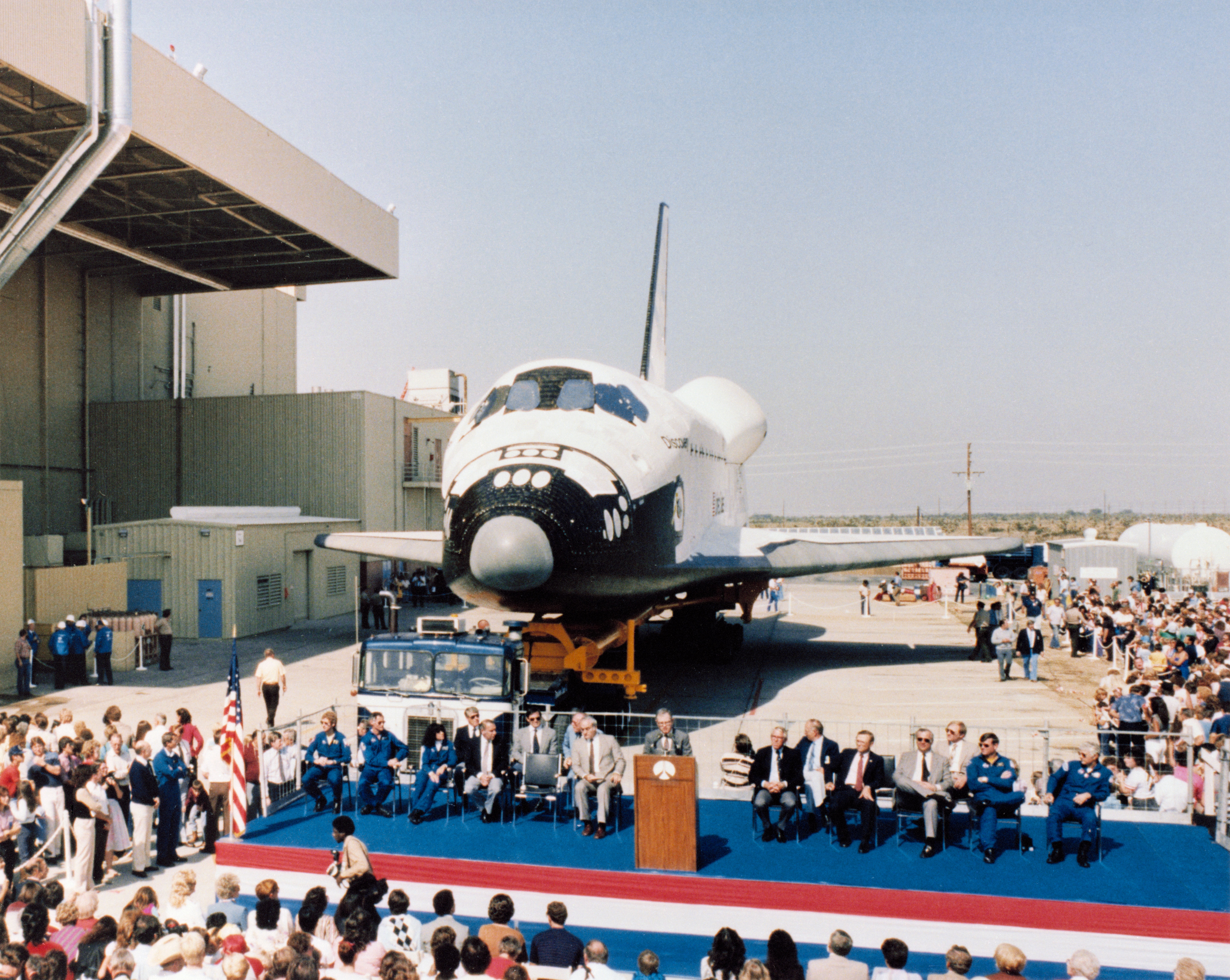
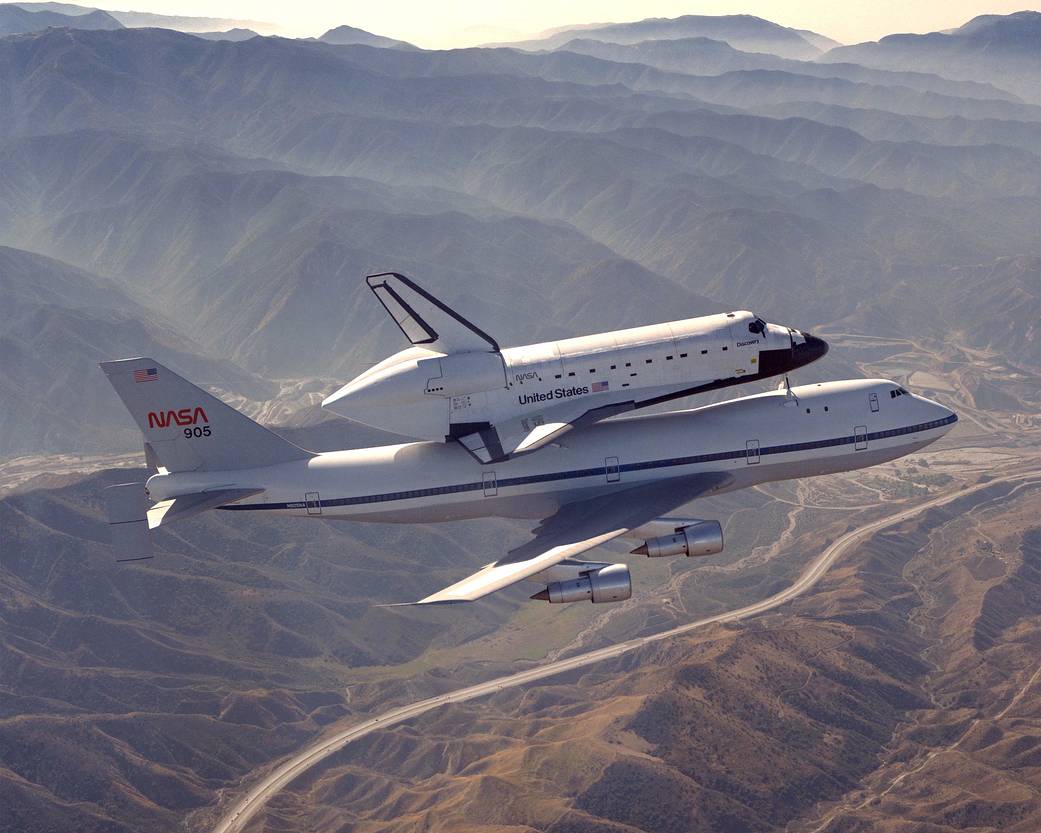
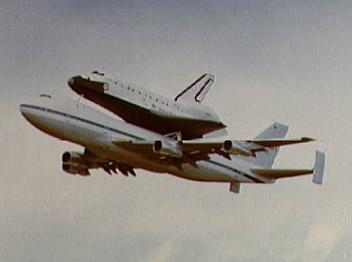
Left: Space shuttle Discovery rolls out of Rockwell’s Palmdale facility. Middle: Discovery atop the Shuttle Carrier Aircraft during the cross-country ferry flight. Right: Discovery arrives at NASA’s Kennedy Space Center in Florida.
Discovery rolled out of Rockwell International’s plant in Palmdale, California, on Oct. 16, 1983. Five of the six crew members assigned to its first flight attended the ceremony. Workers trucked Discovery overland from Palmdale to NASA’s Dryden, now Armstrong, Flight Research Center at Edwards Air Force Base (AFB). Discovery arrived at NASA’s Kennedy Space Center (KSC) on Nov. 9 after a cross-country ferry flight from Edwards, following a two-day stopover at Vandenberg Air Force, now Space Force, Base in California, atop the Shuttle Carrier Aircraft, a modified Boeing 747. Discovery, named after several historical ships of exploration, incorporated manufacturing lessons learned from the first orbiters as well as through the use of more advanced materials. The new vehicle weighed nearly 8,000 pounds less than its sister ship Columbia and 700 pounds less than Challenger.
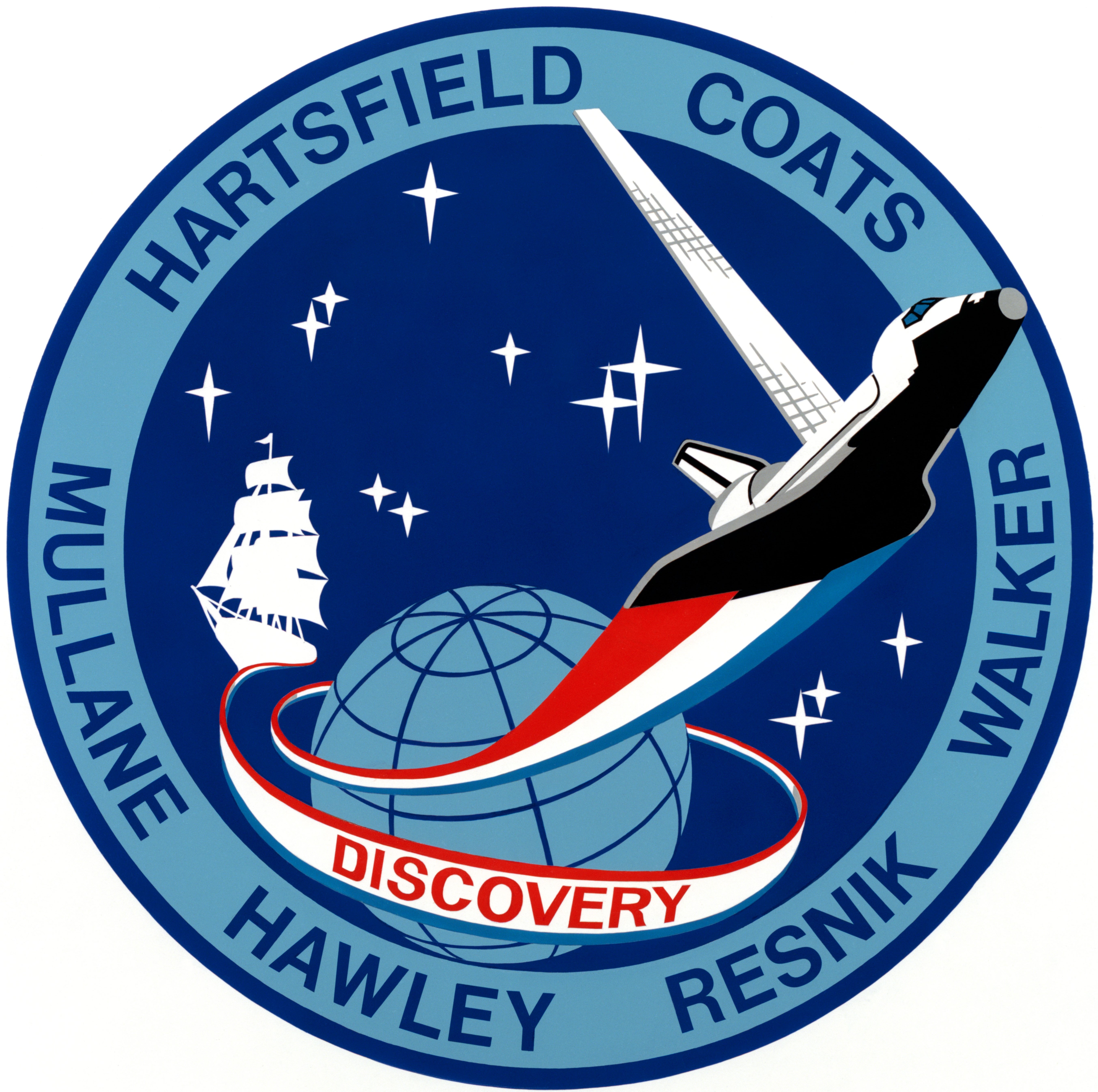

Left: The STS-41D crew patch. Right: The STS-41D crew of R. Michael “Mike” Mullane, front row left, Steven A. Hawley, Henry W. “Hank” Hartsfield, and Michael D. Coats; and Charles D. Walker, back row left, and Judith A. Resnik.
To fly Discovery’s first flight, originally designated STS-12 and later renamed STS-41D, in February 1983 NASA assigned Commander Henry W. Hartsfield, a veteran of STS-4, and first-time flyers Pilot Michael L. Coats, and Mission Specialists R. Michael Mullane, Steven A. Hawley, and Judith A. Resnik, all from the 1978 class of astronauts. In May 1983, NASA announced the addition of Charles D. Walker, an employee of the McDonnell Douglas Corporation, to the crew, flying as the first commercial payload specialist. He would operate the company’s Continuous Flow Electrophoresis System (CFES) experiment. The mission’s primary payloads included the Leasat-1 (formerly known as Syncom IV-1) commercial communications satellite and OAST-1, three experiments from NASA’s Office of Aeronautics and Space Technology, including the Solar Array Experiment, a 105-foot long lightweight deployable and retractable solar array.
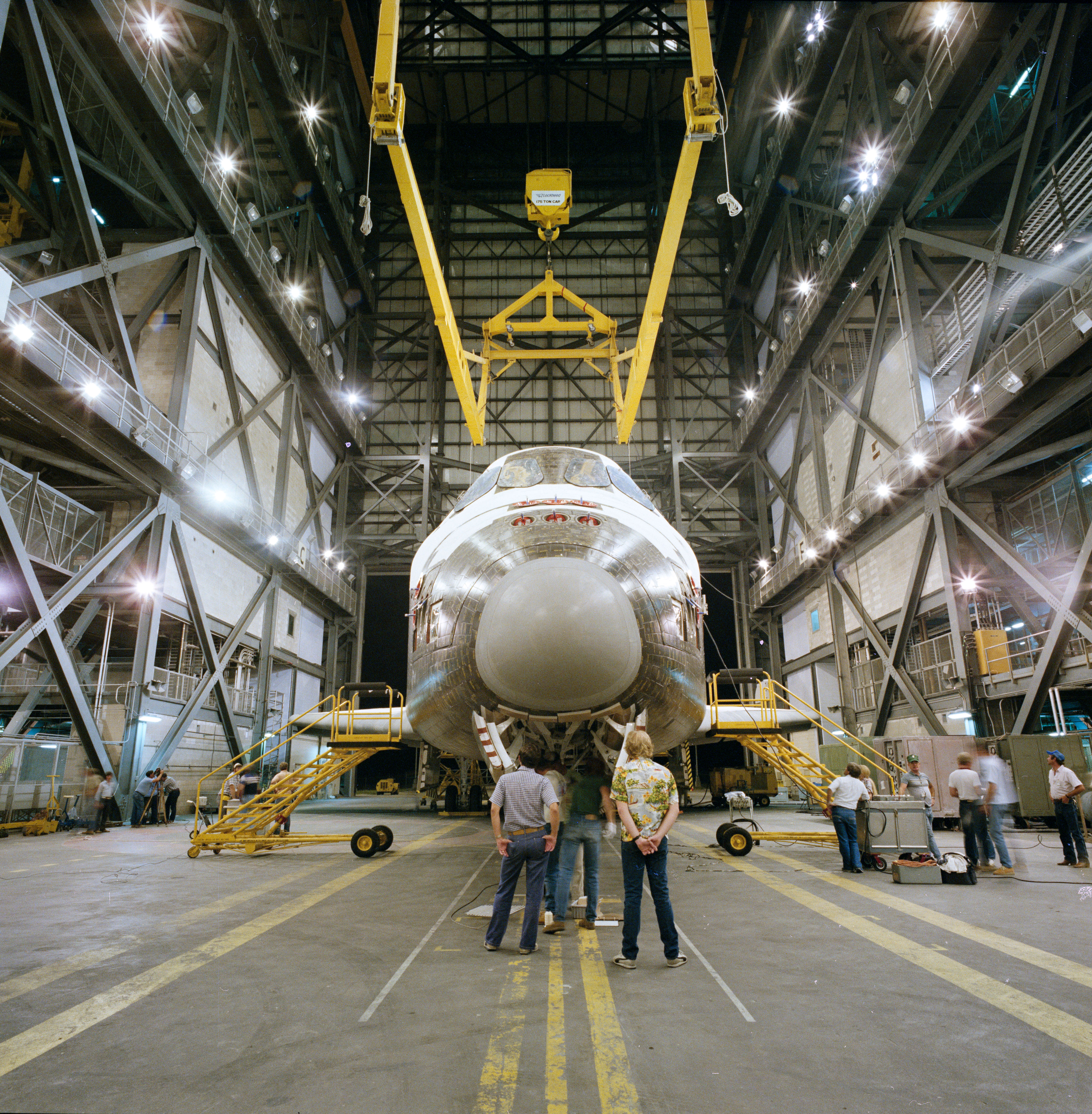
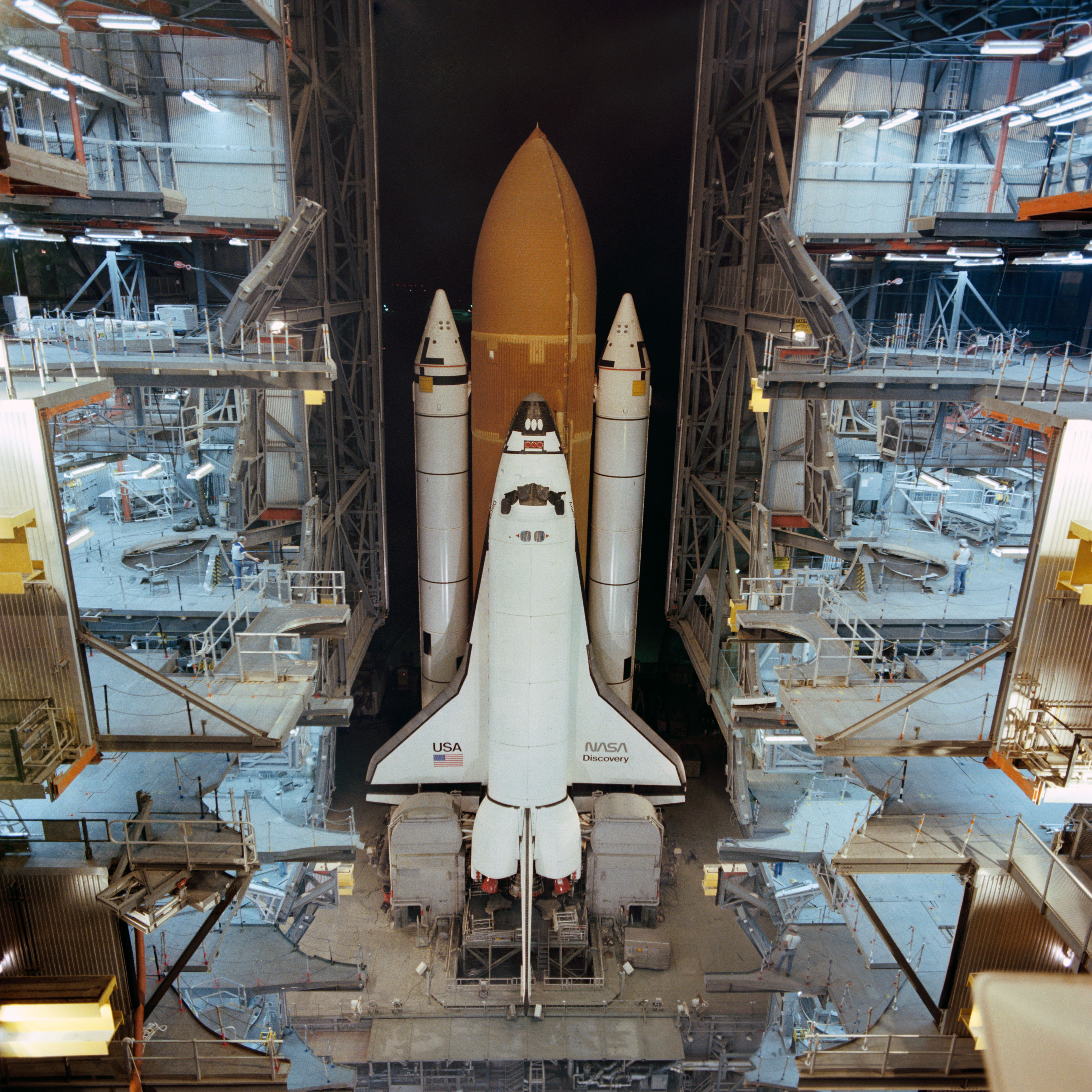

Left: Workers in the Vehicle Assembly Building (VAB) at NASA’s Kennedy Space Center in Florida lift Discovery to mate it with its external tank and solid rocket boosters. Middle: Initial rollout of Discovery from the VAB to Launch Pad 39A on May 19, 1984. Right: The Flight Readiness Firing on June 2.
The day after its arrival at KSC, workers towed Discovery from the SLF to the Orbiter Processing Facility (OPF) to being preparing it for its first space flight. Between Dec. 9, 1983, and Jan. 10, 1984, it entered temporary storage in the Vehicle Assembly Building (VAB) to allow postflight processing of Columbia in the OPF following STS-9. Workers returned Discovery to the OPF for final processing, towing it to the VAB on May 12 for mating with its External Tank (ET) and Solid Rocket Boosters (SRBs). The completed stack rolled out to Launch Pad 39A on May 19. On June 2, engineers successfully completed an 18-second Flight Readiness Firing of the shuttle main engines. Post test inspections revealed a debonding of a thermal shield in main engine number 1’s combustion chamber, requiring its replacement at the pad. The work pushed the planned launch date back three days to June 25.

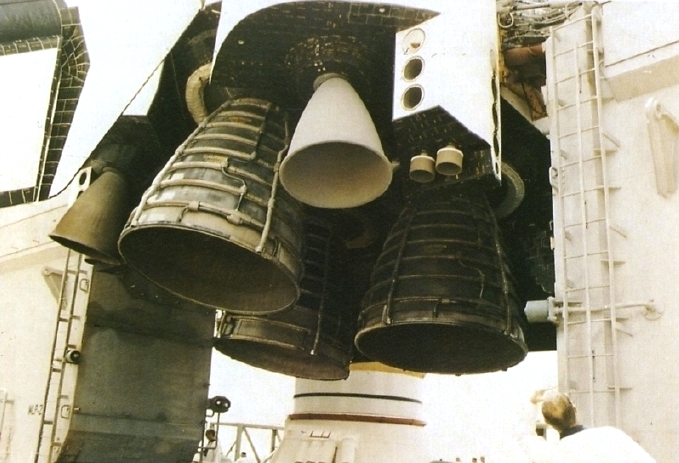
Left: The June 26 launch abort. Right: Discovery’s three main engines hours after the launch abort.
The failure of the shuttle’s backup General Purpose Computer (GPC) caused a one-day delay of the first launch attempt on June 25. On June 26, the countdown proceeded smoothly and at T minus 6.6 seconds the orbiter’s GPCs began the serial ignition sequence of the three main engines. Normally, the three engines ignite at 0.12-second intervals to ease stress on the system and to allow onboard computers to diagnose any problems. Engines number 2 and 3, forming the base of the triangle closest to the body flap, ignited as planned, but engine number 1 at the apex of the triangle and nearest the vertical tail, did not ignite at all. This caused the Redundant Set Launch Sequencer (RSLS) to shut the two working engines down, calling an abort to the countdown at T minus 4 seconds. To ease the tension, Hawley reportedly said, “Gee, I thought we’d be a little higher at main engine cutoff.” The fact that engine number 1 had never ignited caused some momentary confusion as displays showed that the RSLS had not shut it down. A single engine still burning with the shuttle still on the pad would have led to a disaster. Once controllers and the onboard crew realized what had actually happened, they calmed down somewhat. What no one realized at the time is that a hydrogen fire, invisible to the naked eye, had broken out at the aft end of the orbiter. Had the crew evacuated at that time, they would have run through the invisible flames. The pad’s fire suppression system came on to deal with the fire, and when the crew did finally egress the shuttle, they received a good dousing of water. The crew returned safely, if a little drenched, to crew quarters. After ground teams assessed the cause of the abort, they made the decision to roll the stack back to the VAB, demate Discovery from the ET and SRBs and tow it back to the OPF. Workers replaced the faulty engine, and Discovery rolled back out to the launch pad on Aug. 9 for another launch attempt 20 days later, delayed by one day due to a software issue, and finally on Aug. 30, Discovery roared off its launch pad on a pillar of flame and within 8 minutes, NASA’s newest orbiter reached low Earth orbit.
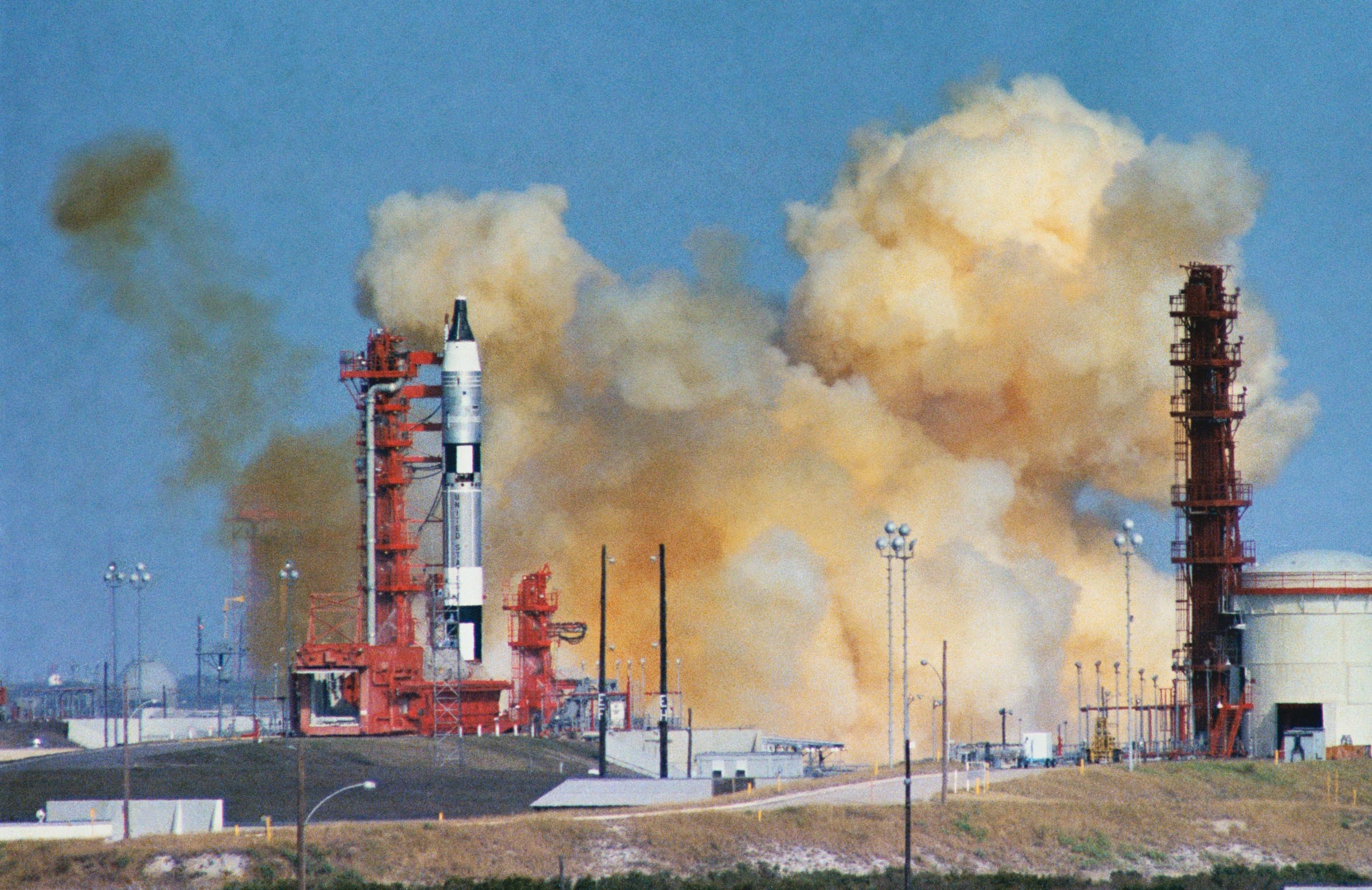

Left: Gemini VI launch pad abort in December 1965. Right: Gemini VI crew of Thomas P. Stafford, left, and Walter M. Schirra.
Although the first on the pad abort of the space shuttle program, the June 1984 attempt to launch Discovery on STS-41D represented the second such incident in the American human spaceflight program. The dubious honor of the first on the pad abort belongs to Gemini VI. On Dec. 12, 1965, astronauts Walter M. Schirra and Thomas P. Stafford strapped into the spacecraft for their second launch attempt to rendezvous with Gemini VII. The countdown clock ticked down to zero, and the Titan-II rocket’s first stage engines ignited. And shut off after just 1.2 seconds. Although the mission clock aboard the spacecraft had started, the rocket had not lifted off, and Schirra made the split-second decision not to eject himself and Stafford from the spacecraft. Engineers later traced the cause of the abort to a dust cap inadvertently left in the engine compartment. After workers took care of that issue, Schirra and Stafford tried to launch again on Dec. 15, and the third time proved to be the charm.
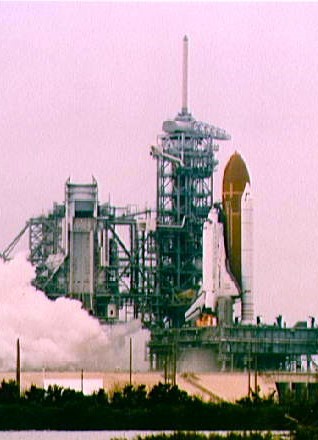
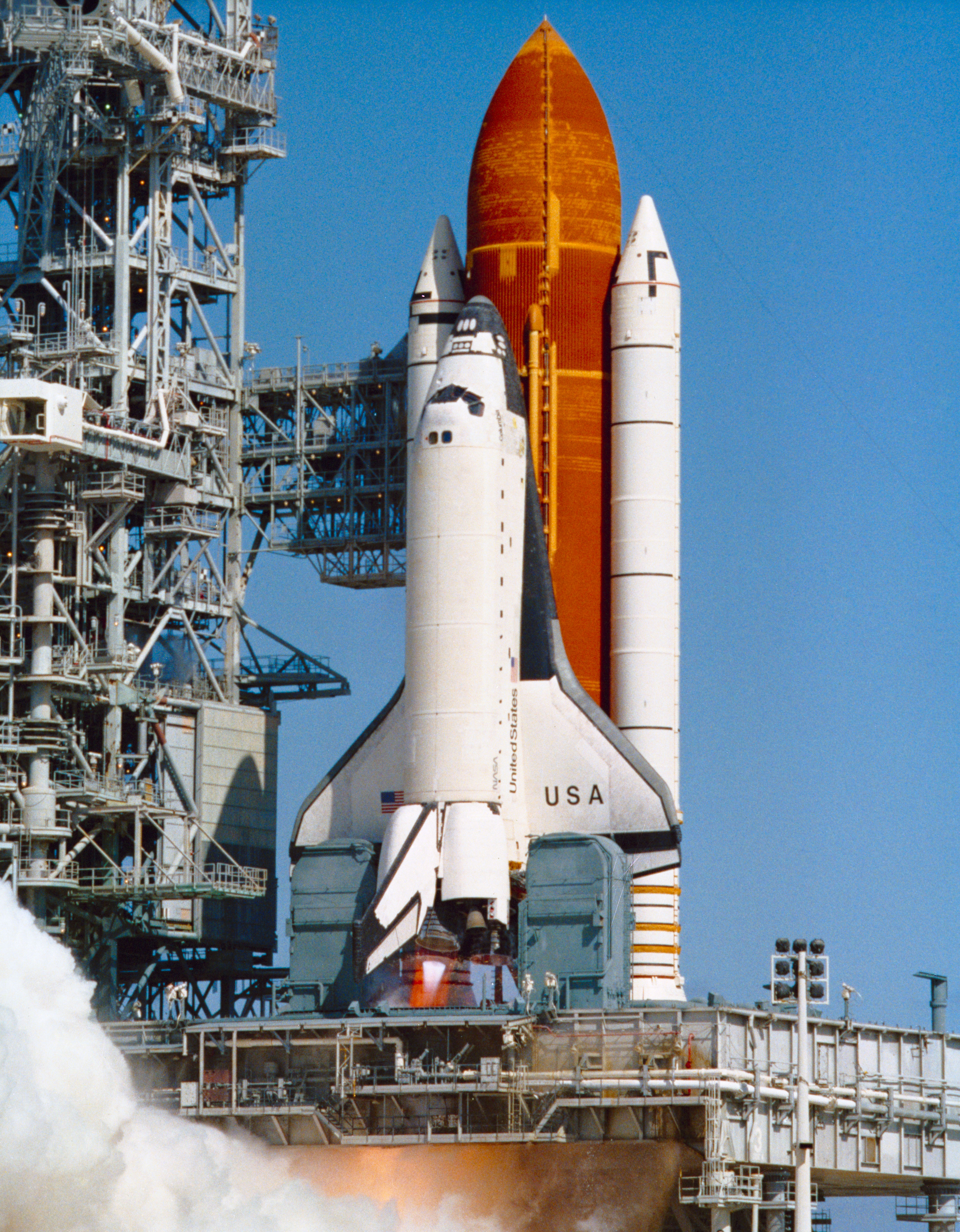


Four space shuttle on-the-pad aborts. STS-51F in August 1985, left, STS-55 in March 1993, STS-51 in August 1993, and STS-68 in August 1994.
In the 10 years following the June 1984 abort, four additional shuttle launch attempts ended with an RSLS abort after at least one main engine had ignited.
July 12, 1985, STS-51F space shuttle Challenger
The RSLS executed a shutdown at T minus 3 seconds, after all three main engines had ignited, because the number two main engine’s chamber coolant valve did not close as rapidly as needed for startup. Investigations revealed a faulty sensor as the real culprit, and workers replaced it at the pad. Challenger launched successfully on July 29, but during ascent engine number 1 shut down, the only inflight failure of a main engine, resulting in the only abort to orbit of the program. Although the shuttle achieved a slightly lower than planned orbit, the mission met most of its science objectives.
March 22, 1993, STS-55 space shuttle Columbia
Following a trouble-free countdown, Columbia’s three main engines came to life at as planned, but three seconds later, the RSLS shut them all down when it detected that engine number 3 had not come up to full power. A tiny fragment of rubber caused a valve in the liquid oxygen system to leak, preventing the engine from fully starting. Columbia borrowed three main engines from Endeavour, and STS-55 took off on April 26 to carry out its German Spacelab-D2 mission.
Aug. 12, 1993, STS-51 space shuttle Discovery
After a trouble-free preflight processing and countdown, Discovery’s three main engines ignited as planned at T minus 6.6 seconds. Three seconds later, all three engines shut down. Investigation revealed the cause as a faulty sensor that monitors fuel flow through main engine number 2. Workers replaced all three engines at the pad, and Discovery took off on Sept. 12 to carry out its mission.
Aug. 18, 1994, STS-68 space shuttle Endeavour
Following a smooth countdown, Endeavour’s three main engines began their startup sequence at T minus 6.6 seconds. The GLS computers detected a problem with the No. 3 main engine’s High Pressure Oxidizer Turbine. One of its sensors detected a dangerously high discharge temperature, exceeding the rules of the Launch Commit Criteria, and Endeavour’s computers halted the countdown a mere 1.9 seconds before liftoff. Workers rolled Endeavour back to the VAB, replacing its three main engines with ones borrowed from Atlantis. STS-68 finally took off on Sept. 30 and successfully completed its radar mapping mission. NASA astronaut Daniel W. Bursch holds the distinction as the only person to have experienced two on-the-pad aborts, as he served as a mission specialist on both STS-51 and STS-68.
The lessons learned from these on-the-pad abort experiences can inform current and future programs. For example, the Space Launch System (SLS) uses main engines leftover from the space shuttle program to power its booster stage. And operationally, other launcher systems can learn from these experiences and safely manage similar future events.
Read recollections of the STS-41D mission by Hartsfield, Coats, Mullane, Hawley, and Walker in their oral histories with the JSC History Office.

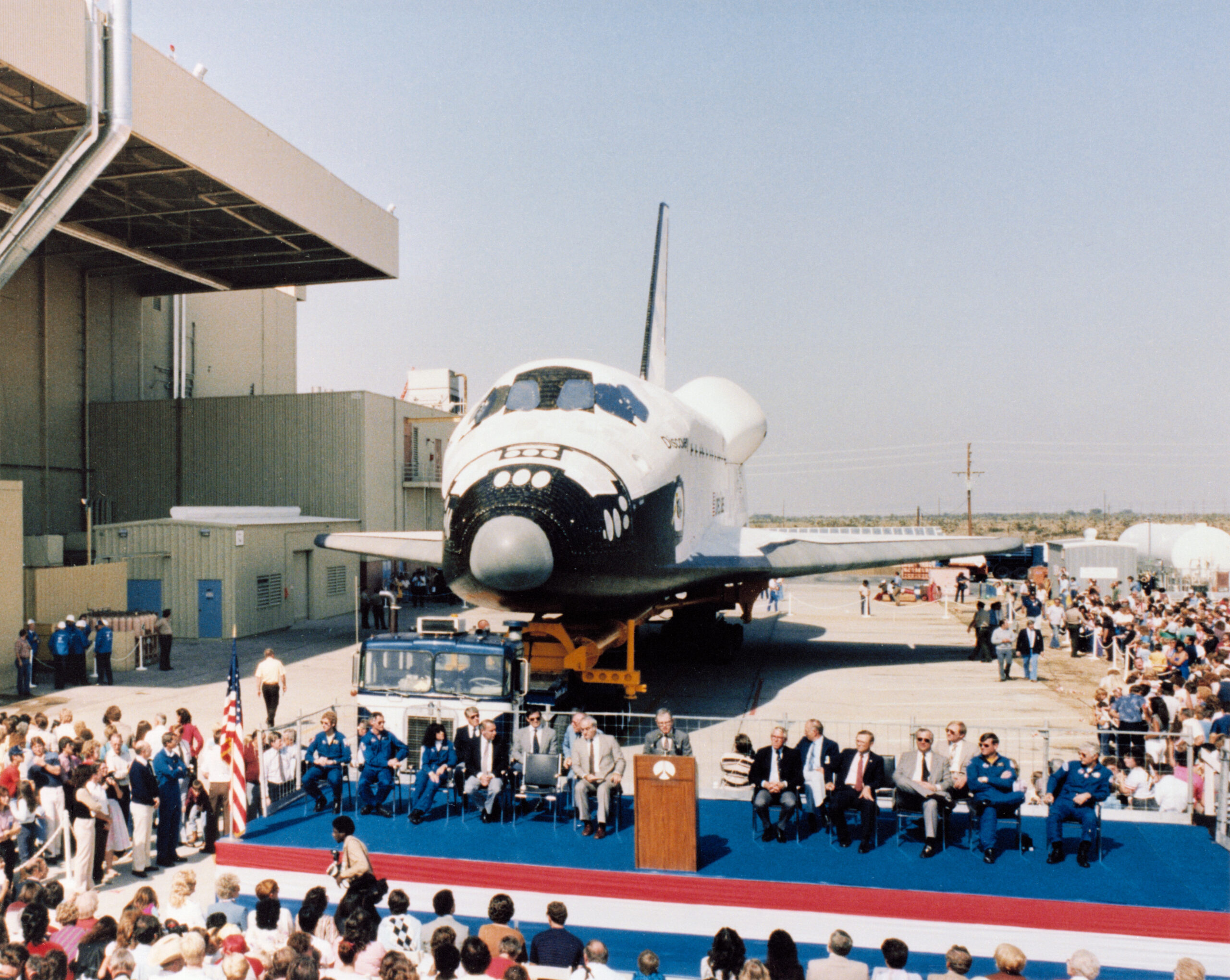
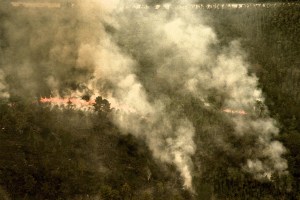 5 min read The 1998 Florida Firestorm and NASA’s Kennedy Space Center Article 6 hours ago
5 min read The 1998 Florida Firestorm and NASA’s Kennedy Space Center Article 6 hours ago 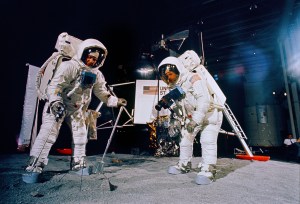 15 min read 55 Years Ago: One Month Until the Moon Landing Article 6 days ago
15 min read 55 Years Ago: One Month Until the Moon Landing Article 6 days ago  2 min read Giant Batteries Deliver Renewable Energy When It’s Needed Article 6 days ago
2 min read Giant Batteries Deliver Renewable Energy When It’s Needed Article 6 days ago